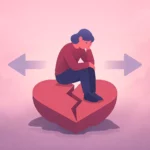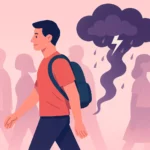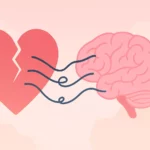Table of Contents
You’re staring at the ceiling at 2 a.m., heart pounding with a mix of sorrow and static silence. The person you leaned on, the one who felt like emotional home—gone. But it’s not just their absence you’re feeling. It’s something deeper, more primal: the panic of detachment. You might feel unworthy. Or numb. Or like you need them to breathe.
These aren’t just feelings. They’re signals from your attachment system—the way your brain and body learned, long ago, how to connect and protect in love. And here’s the part most people never hear: just because you’ve always loved a certain way doesn’t mean you always will. Breakups can hurt like hell, but they can also be portals to profound emotional change.
Can Your Attachment Style Actually Change After a Breakup?

Yes, and the science backs it. Despite what you may have read in pop psychology, attachment style isn’t a permanent personality label. It’s a pattern—one that can shift when your emotional world is disrupted and you’re forced to rebuild.
Studies show that 20–30% of adults change their attachment style within months of a major relationship ending. It makes sense: breakups dismantle your emotional status quo. And in the absence of old habits, something new can be born—especially when you have support and choose reflection over rumination.
This isn’t just about healing from a breakup. It’s about reshaping the way you connect to others—and to yourself.

Why Breakups Hurt So Much (Science of Heartbreak & Healing)
Let’s examine breakups in: Biology of love & loss, Attachment styles, Rejection psychology, Closure, Rumination, Grief
Tap here to read more →Why Insecure Styles Hurt More Post-Breakup
The end of a relationship doesn’t just cut ties—it activates your attachment system.
- Anxious attachment: spirals of overthinking, self-blame, and emotional overwhelm
- Avoidant attachment: emotional shutdown, detachment, and denial of pain
Both styles stem from early experiences but become traps in adulthood—unless recognized and challenged.
Studies show that insecure attachment fuels specific coping strategies: anxious people lean into emotional overdrive; avoidants lean away from emotion altogether. Both delay healing.

How to Start Changing Your Attachment Style After a Breakup
This is where the real transformation begins—not in forgetting the person you lost, but in becoming someone different because of the loss.
- Mindful self-reflection
Ask: What story do I tell myself when love ends? What feelings scare me most? - Secure scaffolding
Therapy, support groups, or trusted friends who offer stability and compassion. - Emotional practice
Stay present with hard feelings. Speak them out loud. Write them down. Choose connection over isolation.
Forgive your past patterns. They were protective. Now, piece by piece, you’re rewiring—not to become perfect, but to become whole.
Your attachment style may have shaped your past relationships. It does not have to define your future ones.
Sometimes healing isn’t about returning to who you were. It’s about becoming someone you’ve never been—safer, softer, stronger within.
FAQ
Q1. Can my attachment style really change after a breakup?
Yes. Research shows that 20–30% of people shift their attachment style within months after a breakup, particularly when they reflect on their emotions, seek support, and practice new relational habits.
Q2. How do I know if I’m anxious or avoidant in a breakup?
Anxious attachment may show as rumination, self-blame, and emotional overdrive, while avoidant attachment often appears as emotional shutdown, distance, and denial of feelings.
Q3. What’s the first step in changing your attachment style after a breakup?
Start with mindful self-reflection—notice your triggers, emotional patterns, and the stories you tell yourself. Awareness is the foundation for breaking old habits and building a more secure style.
Q4. How long does it take to develop a secure attachment after a breakup?
It varies, but meaningful change often happens within months when you consistently use mindful reflection, seek supportive relationships or therapy, and practice emotional openness and boundaries.
Scientific Sources
-
Peter M. McKenzie, Richard A. Bryant (2013): Attachment Styles and Personal Growth following Romantic Breakups
Key Finding: Adults with higher attachment anxiety reported greater personal growth post-breakup thanks to heightened distress that drove reflection, brooding, and rebound behaviors.
Why Relevant: Highlights that although anxious attachment intensifies breakup pain, it can catalyze reflection and growth—informing pathways for change.
https://www.ncbi.nlm.nih.gov/pmc/articles/PMC3774645/ -
Fagundes et al. (2012): Attachment, Coping, and Breakup Distress: The Mediating Role of Coping
Key Finding: Attachment anxiety predicted prolonged distress through maladaptive coping (rumination, self-blame), while avoidant attachment also influenced distress via avoidance strategies.
Why Relevant: Demonstrates specific coping strategies linked to insecure attachment—change efforts must address these mechanisms.
https://www.ncbi.nlm.nih.gov/pmc/articles/PMC10727987/ -
M. Mikulincer & P.R. Shaver (2023): Attachment theory expanded: security dynamics in individuals…
Key Finding: Longitudinal data shows that 20–30% of adults change attachment style (e.g., post-separation) within weeks or months; stressors like breakups can shift insecure toward more secure styles.
Why Relevant: Confirms that attachment styles aren’t fixed and can be altered after breakups, especially via targeted reflection and changes in support.
https://en.wikipedia.org/wiki/Attachment_in_adults
- Attachment Wounds Explained: Powerful Ways to Start Healing After Heartbreak

- Powerful Healing: Changing Your Attachment Style After a Breakup

- The Painful Truth About Your Ex’s Attachment Style (and Why You Still Feel Haunted)

- The Powerful Link Between Attachment Style and Healing After a Breakup

- Secure Attachment Breakup Recovery: The Surprisingly Peaceful Grief Style

- Disorganized Attachment Breakup: Surviving the Push-Pull Grief Storm

- Avoidant Attachment Breakup: The Surprising Crash After Calm

- Anxious Attachment After Breakup: Why You Spiral and How to Heal

- Attachment Style and Breakups: Discover the Powerful Science Behind Why It Hurts


Leave a Reply